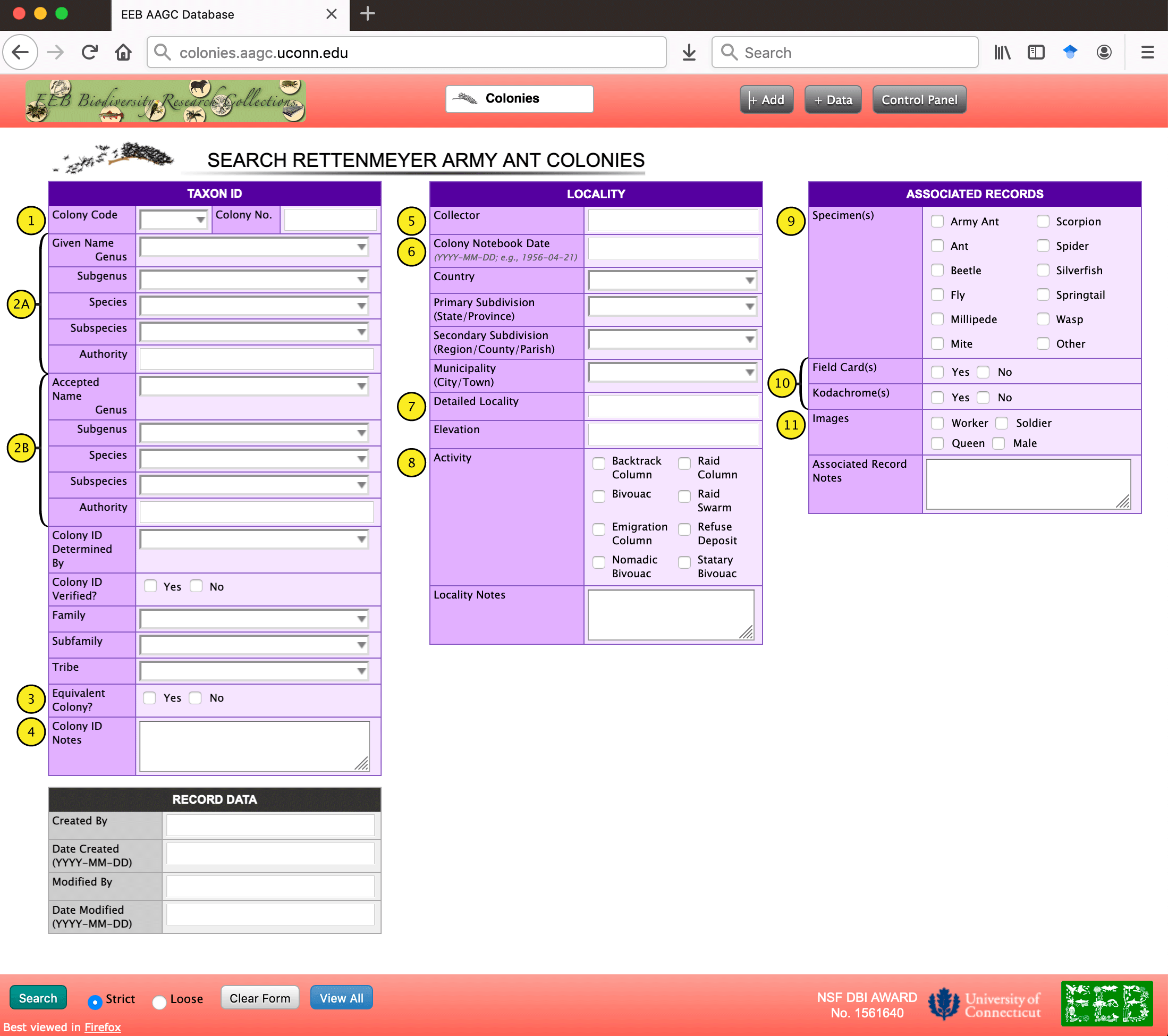1: Colony Code & Number
The Colony Code tells users what kind of colony they are viewing, and distinguishes between army ant and prey colonies.
- E = originally intended to be “Eciton” colonies, these are army ant colonies first identified by Carl Rettemeyer over the course of his 50+ years of collecting in the Americas.
- D = these army ant colonies were collected and tracked by the many collaborators Carl Rettenmeyer worked with over the decades.
- F = Although they include species in the Formicidae, these colonies represent prey colonies tracked by Carl Rettenmeyer.
- V = Wasp colonies tracked and sampled as part of graduate student Ruth Chadab’s dissertation.
The Colony Code and Number together create the unique identifier for each colony (e.g., E-529 or V-46).
2A: Given Name
Given Names are the species names as originally recorded in colony notebooks, field notes, or on specimen labels.
2B: Accepted Name
Accepted Names are the currently accepted species names as determined by consulting AntWeb. These take into consideration taxonomic actions taken since the identities were originally determined and recorded.
3: Equivalent Colonies
After consulting and comparing specimen labels and other collection resources, it was determined that some colonies are actually equivalent to each other; i.e., the same colony was documented and sampled at different times, and assigned different numbers.
4: Colony ID Notes
When taxonomic information includes question marks, abbreviations or has been crossed out, only those taxonomic levels that can be determined have been entered in the taxon name fields. Questionable, partial or original ID names are included in the Colony ID Notes field.
5: Collector
The Collector field contains the name of the person who first documented and/or sampled a colony. If a colony record does not include a Collector, one could be unambiguously identified from any collection resources.
6: Colony Notebook Date
A lot of colony data is drawn from a series of “colony notebooks” compiled by Carl Rettenmeyer and his students and collaborators. Colony Notebook Dates are the dates indicated in these notebooks. If a colony is not recorded formally in a notebook, the date from the first specimen collected from that colony is used.
The dates have been standardized to ISO 8601 date format with the year is listed first, followed by a two-digit month and day (e.g., September 8, 1967 is displayed as “1967-09-08”). All dates are in ISO format with the year first. Searches can be performed for specific years by entering a year only, or for specific months by entering “-MM-“ (e.g., “-11-“ for November).
7: Detailed Locality
Detailed Localities have been compiled from a number of sources, including colony notebooks and specimen labels. These include information such as Barro Colorado Island trail names (where many specimens were collected) and the distances from landmarks where colonies were first located.
Users can search for simple text strings in this field.
8: Activity
Users may search for what activity phase a colony was recorded in when it was observed or sampled. If multiple Activities are checked, the search will return only those colonies documented during ALL the selected activities (e.g., selecting “Raid Column” and “Raid Swarm” will only return the 23 colonies that was recorded during both of those activities).
9: Associated Specimen(s)
Users may search for those colonies that have specific kinds of specimens by selecting the relevant specimen types in this box. Selecting “Ant” will return colonies where prey or other kinds of ants were collected. Selecting multiple kinds of specimens at the same time will return colonies with both kinds of associated specimen records (e.g., selecting “Army Ant” and “Mite” will return colonies with both kinds of specimens linked).
10: Field Card(s) and Kodachrome(s)
These two fields allow a user to find only those colonies that have Kodachrome slides or field cards linked.
11: Images
Images of Colony Exemplars have been taken for a subset of colonies. These include photos of pinned worker and soldiers from any given colony. The process of locating and photographing exemplars is on-going.
